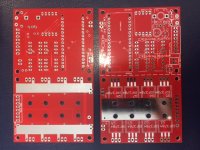I have had some good experience with copper. I built a 20s5p pack for current flow of up to 60amps.
It took a lot of faffing around to get started, but this is what worked
Home built transformer based spotwelder ( initially a MOT then bigger- bigger was much better, the MOT struggled)
Copper electrodes (anything else stuck like bug grey)
Slotted tabs
Clean smooth surfaces
.1x8mm copper (pure, not plated)
I put a P layer of nickel strip (.15x8mm) down to join and protect the cells ( from the inevitable blowouts)
Then I welded the copper S connectors to this. It's more difficult than nickel welding and weaker. If I tested the welds to firmly the copper would tear.
Tungsten (tipped) electrodes are apparently the bees knees but I didn't have the power to drive them. If you do, then the resistance of the W heats and welds the copper. RTL had great success with this method. For me, with W electrodes, I had unbelievably good welds... of the electrode to the work piece

, such that I would have to tear it off with such force as to destroy the tab and can.
Short high amp pulses are the key. And repeatability. Hand held electrodes would be tough bc of the inconsistency.
Slow going but makes for good current flow...
K




